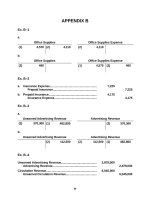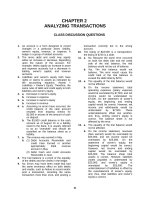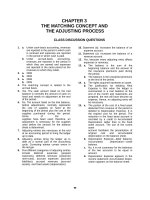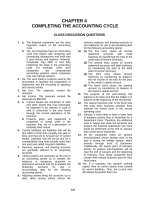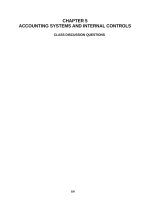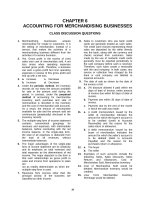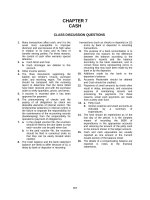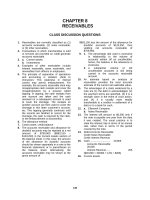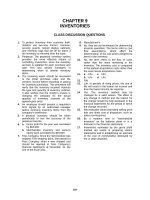Solution manual accounting 21e by warreni ch 21
Bạn đang xem bản rút gọn của tài liệu. Xem và tải ngay bản đầy đủ của tài liệu tại đây (219.89 KB, 57 trang )
CHAPTER 21
BUDGETING
CLASS DISCUSSION QUESTIONS
1. The three major objectives of budgeting are
(1) to establish specific goals for future
operations, (2) to direct and coordinate
plans to achieve the goals, and (3) to
periodically compare actual results with the
goals.
2. Managers
are
given
authority
and
responsibility for responsibility center
performance. They are then accountable for
the performance of the responsibility center.
3. If goals set by the budgets are viewed as
unrealistic or unachievable, management
may become discouraged and may not be
committed to the achievement of the goals,
resulting in the budget becoming less
effective as a planning and control tool.
4. Involving all levels of management and all
departments in preparing and submitting
budget estimates heightens awareness of
each department’s importance to company
goals and to the control of operations. It
also encourages cooperation both within
and among departments.
5. Budgeting more resources for travel than requested by department personnel is an
example of budgetary slack.
6. A budget that is set too loosely may fail to
motivate managers and other employees to
perform efficiently. In addition, a loose budget
may cause a “spend it or lose it” mentality,
where excess budget resources are spent in
order to protect the budget from future
reductions.
7. Conflicting goals can cause employees to
act in their own self-interests to the
detriment of the organization’s objectives.
8. Zero-based budgeting is used when an
organization wishes to take a “clean slate”
view of operations. It is often used when the
organization wants to cut costs by
reevaluating the need for and usefulness of
all operations.
9. A static budget is most appropriate in
situations where costs are not variable to an
underlying activity level. As a result, it is
reasonable to plan spending on the basis of a
fixed quantity of resources for the year. This
10.
11.
12.
13.
14.
15.
16.
157
will occur in some administrative functions,
such as human resources, accounting, or
public relations.
Computers not only speed up the budgeting
process, but they also reduce the cost of
budget preparation when large quantities of
data need to be processed. In addition, by
using computerized simulation models,
management can determine the impact of
various operating alternatives on the master
budget.
The first step in preparing a master budget
is estimating the sales levels of each
product by regions or territories.
The production requirements must be carefully coordinated with the sales budget to
ensure that production and sales are kept in
balance
during
the period.
Ideally,
manufacturing
operations
should
be
maintained at 100% of capacity, with no idle
time or overtime, and there should be
neither excessive inventories nor inventories
insufficient to fill sales orders.
Purchases of direct materials should be
closely coordinated with the production budget so that inventory levels can be
maintained within reasonable limits.
Direct materials purchases budget, direct
labor cost budget, and factory overhead
cost budget.
a. The cash budget contributes to effective
cash planning. This involves advance
planning so that a cash shortage does
not arise and excess cash is not
permitted to remain “idle.”
b. The excess cash can be invested in
readily marketable income-producing
securities or used to reduce loans.
The schedule of collections from sales is
used to determine the amount of cash
collected from current and prior period
sales, based on collection history. The
schedule is used to help determine the
estimated cash receipts portion of the cash
budget.
17. The plans for financing the capital
expenditures budget may affect the cash
budget.
158
EXERCISES
Ex. 21–1
a.
HAKIM DAVIS
Cash Budget
For the Four Months Ending December 31, 2006
September
Estimated cash receipts from:
Part-time job..........................
Deposit..................................
Total cash receipts..........
Estimated cash payments for:
Season football tickets.........
Additional entertainment......
Tuition....................................
Rent.......................................
Food......................................
Deposit..................................
Total cash payments.......
Cash increase (decrease)..........
Cash balance at beginning
of month................................
Cash balance at end of month. .
October
November December
$ 1,000
$1,000
$1,000
$ 1,000
$1,000
$1,000
$ 1,000
500
$ 1,500
$ 250
$ 250
$
400
320
400
320
$ 970
$ 30
$ 970
$ 30
$
$
2,100
$2,130
2,130
$2,160
2,160
$ 2,690
$
180
250
3,250
400
320
500
$ 4,900
$(3,900)
6,000
$ 2,100
250
400
320
970
530
b. The four-month budgets do not change with any identified activity level; thus,
they are static budgets.
c. While Davis’s budget might first appear satisfactory, Davis must earn enough
cash in order to pay for the spring semester tuition. His present budget
shows that he will be $560 short of the tuition amount ($3,250 – $2,690). Thus,
Davis will likely need to adjust the plan before the fall term even begins.
Some possibilities would be to rent a lower cost apartment or to get a
roommate so that the rental cost is cut in half. The additional $200 per month
would yield $800 by the end of December, which would be sufficient to cover
the $560 spring tuition shortfall and provide a little extra. Other
considerations include increasing his part-time job hours and reducing his
monthly entertainment and food allowance, or making up the income
difference with additional hours during Christmas break. The budget gives
Davis time to adjust his plans to future events. In this case, Davis can see
that his present plan will not provide sufficient cash, thus giving him four
months to adjust. If Davis did not budget but went ahead with the original
plan, he would be $560 short at the end of December with no time left to
adjust.
158
Ex. 21–2
CENTRAL INDUSTRIAL SUPPLY
Flexible Selling and Administrative Expenses Budget
For the Month Ending May 31, 2006
Total sales........................................................
$100,000
$115,000
$130,000
Variable cost:
Sales commissions....................................
Advertising expense..................................
$
$
5,750
17,250
$ 6,500
19,500
3,000
2,000
4,000
$ 29,000
3,450
2,300
4,600
$ 33,350
3,900
2,600
5,200
$ 37,700
$
$
$ 2,000
10,000
1,500
$ 13,500
$ 51,200
Miscellaneous selling expense.................
Office supplies expense............................
Miscellaneous administrative expense....
Total variable cost................................
Fixed cost:
Miscellaneous selling expense.................
Office salaries expense.............................
Miscellaneous administrative expense....
Total fixed cost.....................................
Total selling and administrative expenses....
159
5,000
15,000
2,000
10,000
1,500
$ 13,500
$ 42,500
2,000
10,000
1,500
$ 13,500
$ 46,850
Ex. 21–3
a.
TOWERS COMPANY—MOLDING DEPARTMENT
Flexible Production Budget
For the Three Months Ending March 31, 2006
January
February
March
Units of production........................
55,000
50,000
45,000
Wages.............................................
Utilities............................................
Depreciation...................................
Total................................................
$594,000
99,000
70,000
$763,000
$540,000
90,000
70,000
$700,000
$486,000
81,000
70,000
$637,000
Units of production........................
Hours per unit................................
Total hours of production..............
Wages per hour..............................
Total wages....................................
January
March
55,000
×
0.60
33,000
× $18.00
$594,000
50,000
×
0.60
30,000
× $18.00
$540,000
45,000
×
0.60
27,000
× $18.00
$486,000
Total hours of production..............
Utility cost per hour.......................
Total utilities...................................
33,000
× $3.00
$ 99,000
30,000
× $3.00
$ 90,000
27,000
× $3.00
$ 81,000
Supporting calculations:
Depreciation is a fixed cost, so it does not “flex” with changes in production.
Since it is the only fixed cost, the variable and fixed costs are not classified in the
budget.
b.
Total flexible budget......................
Actual cost.....................................
Excess of actual cost over budget
January
$763,000
775,000
$ (12,000)
February
$700,000
720,000
$ (20,000)
March
$637,000
665,000
$ (28,000)
The excess of actual cost over the flexible budget suggests that the Molding Department has not performed as well as originally thought. Indeed, the department
is spending more than would be expected, and it's getting worse, given the level
of production for the first three months.
160
Ex. 21–3
Continued
This solution is applicable only if the P.A.S.S. Software that accompanies the
text is used.
TOWERS COMPANY
Budget Report
For the Period Ended January 31, 2006
Budget
Actual
Difference
from Budget
%
$825,000
$810,000
$(15,000)
(1.82)
Operating expenses:
January wages......................
$594,000
$565,000
January utilities....................
99,000
135,000
January depreciation............
70,000
75,000
Total operating expenses$763,000$775,000
$
Net income (loss).......................
$ 62,000
$ 35,000
$(29,000)
36,000
5,000
12,000
$(27,000)
(4.88)
36.36
7.14
1.57
(43.55)
Operating revenue.....................
TOWERS COMPANY
Budget Report
For the Period Ended February 28, 2006
Difference
from Budget
Budget
Actual
$850,000
$820,000
$(30,000)
(3.53)
Operating expenses:
February wages....................
$540,000
$489,000
February utilities...................
90,000
156,000
February depreciation..........
70,000
75,000
Total operating expenses$700,000$720,000
$
Net income (loss).......................
$150,000
$100,000
$(51,000)
66,000
5,000
20,000
$(50,000)
(9.44)
73.33
7.14
2.86
(33.33)
Operating revenue.....................
161
%
Ex. 21–3
Concluded
TOWERS COMPANY
Budget Report
For the Period Ended March 31, 2006
Difference
from Budget
Budget
Actual
$800,000
$750,000
$(50,000)
(6.25)
Operating expenses:
March wages.........................
$486,000
$495,000
March utilities.......................
81,000
95,000
March depreciation...............
70,000
75,000
Total operating expenses$637,000$665,000
$
Net income (loss).......................
$163,000
$ 85,000
$ 9,000
14,000
5,000
28,000
$(78,000)
1.85
17.28
7.14
4.40
(47.85)
Operating revenue.....................
%
Ex. 21–4
STEELCASE CORPORATION
Fabrication Department
May 2006
(assumed data)
Units of production....................
Variable cost:
Direct labor............................
Direct materials.....................
Total variable cost...........
Fixed cost:
Supervisor salaries...............
Depreciation..........................
Total fixed cost................
Total department cost................
15,000
$
$
$
$
17,500
20,000
84,0001
900,0004
984,000
$
98,0002
1,050,0005
$ 1,148,000
$
125,000
30,000
155,000
$
$
$ 1,139,000
1
15,000 × 24/60 × $14
17,500 × 24/60 × $14
3
20,000 × 24/60 × $14
4
15,000 × 40 × $1.50
5
17,500 × 40 × $1.50
6
20,000 × 40 × $1.50
2
162
$
125,000
30,000
155,000
$ 1,303,000
112,0003
1,200,0006
$ 1,312,000
$
125,000
30,000
155,000
$ 1,467,000
Ex. 21–5
a.
HARMONY AUDIO COMPANY
Sales Budget
For the Month Ending September 30, 2007
Unit
Sales Volume
Unit
Selling Price
Model DL:
East Region................................
West Region...............................
Total.......................................
4,200
3,150
7,350
$125
125
$ 525,000
393,750
$ 918,750
Model XL:
East Region................................
West Region...............................
Total.......................................
3,000
2,200
5,200
$180
180
$ 540,000
396,000
$ 936,000
Product and Area
Total revenue from sales................
Total
Sales
$ 1,854,750
b.
HARMONY AUDIO COMPANY
Production Budget
For the Month Ending September 30, 2007
Expected units to be sold....................................................
Plus desired inventory, September 30, 2007......................
Total................................................................................
Less estimated inventory, September 1, 2007....................
Total units to be produced...................................................
163
Model DL
7,350
410
7,760
350
7,410
Units
Model XL
5,200
100
5,300
120
5,180
Ex. 21–6
JEFFRIES AND VALDEZ, CPAs
Professional Fees Budget
For the Year Ending December 31, 2006
Audit Department:
Staff.......................................................
Partners.................................................
Total..................................................
Tax Department:
Staff.......................................................
Partners.................................................
Total..................................................
Computer Consulting Department:
Staff.......................................................
Partners.................................................
Total..................................................
Total professional fees..............................
Billable
Hours
Hourly
Rate
Total
Revenue
32,500
4,800
37,300
$110
$250
$ 3,575,000
1,200,000
$ 4,775,000
28,700
3,950
32,650
$110
$250
$ 3,157,000
987,500
$ 4,144,500
24,600
5,700
30,300
$110
$250
$ 2,706,000
1,425,000
$ 4,131,000
$ 13,050,500
Ex. 21–7
JEFFRIES AND VALDEZ, CPAs
Professional Labor Cost Budget
For the Year Ending December 31, 2006
Audit Department............................................................
Tax Department...............................................................
Computer Consulting Department.................................
Total..........................................................................
Average compensation per hour....................................
Total labor cost...............................................................
164
Billable Hours Required
Staff
Partners
32,500
4,800
28,700
3,950
24,600
5,700
85,800
14,450
× $50.00
× $150.00
$4,290,000
$ 2,167,500
Ex. 21–8
TASTE OF ITALY FROZEN PIZZA INC.
Direct Materials Purchases Budget
For the Month Ending August 31, 2006
Dough
Units required for production:
12" pizza................................
16" pizza................................
Plus desired inventory,
August 31, 2006....................
Total............................................
Less estimated inventory,
August 1, 2006......................
Total units to be purchased.......
Unit price....................................
Total direct materials to be
purchased.............................
Tomato
Cheese
18,2001
36,9004
9,1002
19,6805
12,7403
27,0606
450
55,550
240
29,020
350
40,150
600
54,950
× $1.40
180
28,840
× $2.20
480
39,670
× $2.60
$ 76,930
$ 63,448
$103,142
1
18,200 × 1 lb.
18,200 × 0.50 lb.
3
18,200 × 0.70 lb.
4
24,600 × 1.50 lbs.
5
24,600 × 0.80 lb.
6
24,600 × 1.10 lbs.
2
165
Total
$243,520
Ex. 21–9
COCA-COLA ENTERPRISES—CHATTANOOGA PLANT
Direct Materials Purchases Budget
For the Month Ending September 30, 2006
(assumed data)
Carbonated
Concentrate
2-Liter Bottles
Water
Materials required for production:
Coke.................................
712* pounds 178,000 bottles
Sprite................................
426*
142,000
Total materials.......................
1,138 pounds 320,000 bottles
Direct material unit price...... × $80
× $0.09
Total direct materials to be
purchased........................ $91,040
$ 28,800
*Production in liters (bottles × 2 liters/bottle).........
Divide by 100............................................................
Multiply by concentrate pounds per 100 liters.......
Concentrate pounds required for production........
166
Coke
356,000
÷
100
3,560
× 0.20
712
356,000 liters
284,000
640,000 liters
× $0.04
$ 25,600
Sprite
284,000
÷
100
2,840
× 0.15
426
Ex. 21–10
GOODMAN TIRE COMPANY
Direct Materials Purchases Budget
For the Year Ending December 31, 2006
Rubber
Steel Belts
Total
Pounds required for production:
Passenger tires1.................................
962,500 lbs. 115,500 lbs.
Truck tires2......................................... 1,110,000
148,000
Plus desired inventory, Dec. 31, 2006....
40,000
6,000
Total......................................................... 2,112,500 lbs. 269,500 lbs.
Less estimated inventory, Jan. 1, 2006. .
70,000
5,000
Total units purchased............................. 2,042,500 lbs. 264,500 lbs.
Unit price................................................. ×
$2.80
× $3.60
Total direct materials to be purchased. . $5,719,000
$952,200
$6,671,200
1
Rubber: 38,500 units × 25 lbs. per unit = 962,500 lbs.
Steel belts: 38,500 units × 3 lbs. per unit = 115,500 lbs.
2
Rubber: 18,500 units × 60 lbs. per unit = 1,110,000 lbs.
Steel belts: 18,500 units × 8 lbs. per unit = 148,000 lbs.
Errors:
1.
The sales should be adjusted by the desired ending inventory in the finished
goods in order to determine the number of units to be produced (38,500 for
passenger tires and 18,500 for truck tires). The desired ending inventory
should be added to the sales figures to determine the current period
production requirements.
2. The materials used to satisfy current period production should be adjusted
by the estimated beginning materials inventory and desired ending materials
inventory to determine materials to be purchased.
167
Ex. 21–11
ACE RACKET COMPANY
Direct Labor Cost Budget
For the Month Ending August 31, 2006
Forming
Department
Hours required for production:
Junior1...................................................................
Ace Master2...........................................................
Total.................................................................
Hourly rate..................................................................
Total direct labor cost................................................
1
Junior: 0.20 hour × 5,300 = 1,060 hours
0.30 hour × 5,300 = 1,590 hours
2
Ace Master: 0.30 hour × 19,600 = 5,880 hours
0.50 hour × 19,600 = 9,800 hours
168
1,060
5,880
6,940
× $19.00
$131,860
Assembly
Department
1,590
9,800
11,390
× $12.00
$136,680
Ex. 21–12
City Suites Hotels, Inc.
Direct Labor Cost Budget
For a Weekday or a Weekend Day
Weekday
Weekend day
Room occupancy
Room capacity
Occupied percent (occupancy)
Rooms occupied
200
× 80%
160
200
× 40%
80
(c)
Housekeeping
No. of minutes to clean a room
Total minutes [(a) × (b)]
Total hours (÷ 60 min.)
Labor rate per hour
Housekeeping daily labor budget
45
7,200
120.00
×$9.00
$ 1,080
45
3,600
60.00
×$9.00
$ 540
(d)
Restaurant staff
Base restaurant staff
Incremental 20 room blocks [(a) ÷ 20]
Total staff
Total hours (× 8 hours)
Labor rate per hour
Restaurant staff daily labor budget
4
8
12
96
×$8.00
$ 768
4
4
8
64
×$8.00
$ 512
Total daily labor budget [(c) + (d)]
$1,848
$ 1,052
(a)
(b)
169
Ex. 21–13
a.
Levi Strauss & Co.
Production Budget
March 2006
(assumed data)
Dockers®
501 Jeans®
21,600
250
(300)
21,550
43,400
100
(140)
43,360
Expected units to be sold...............................
Plus: March 31 desired inventory..................
Less: March 1 estimated inventory................
Total units to be produced.............................
b.
Levi Strauss & Co.
Direct Labor Cost Budget
March 2006
(assumed data)
Inseam
Outerseam
Pockets
Zipper
Dockers®............................
32,325*
43,100*
10,775*
12,930*
501 Jeans®.........................
52,032**
60,704**
34,688**
26,016**
Total minutes......................
84,357
103,804
45,463
38,946
Total direct labor
hours (÷ 60 minutes).....
1,405.95
1,730.07
757.72
649.10
× Direct labor rate............... ×
$11.00 ×
$11.00 × $13.00
× $13.00
Total direct labor cost........ $ 15,465.45
$ 19,030.77 $ 9,850.36
$8,438.30
* (21,550/10 pairs) ×
(21,550/10 pairs) ×
(21,550/10 pairs) ×
(21,550/10 pairs) ×
15 min.
20 min.
5 min.
6 min.
=
=
=
=
32,325 minutes
43,100 minutes
10,775 minutes
12,930 minutes
** (43,360/10 pairs) ×
(43,360/10 pairs) ×
(43,360/10 pairs) ×
(43,360/10 pairs) ×
12 min.
14 min.
8 min.
6 min.
=
=
=
=
52,032 minutes
60,704 minutes
34,688 minutes
26,016 minutes
170
Ex. 21–14
DUTCH SHOE COMPANY
Factory Overhead Cost Budget
For the Month Ending January 31, 2006
Variable factory overhead costs:
Manufacturing supplies..............................................
Power and light...........................................................
Production supervisor wages....................................
Production control salaries.......................................
Materials management salaries.................................
Total variable factory overhead costs...................
Fixed factory overhead costs:
Factory insurance.......................................................
Factory depreciation...................................................
Total fixed factory overhead costs........................
Total factory overhead costs............................................
$ 12,000
45,000
115,000
32,000
25,000
$229,000
$ 22,000
19,000
41,000
$270,000
Note: Advertising expenses, sales commissions, and executive officer salaries
are selling and administrative expenses.
171
Ex. 21–15
UNION CHEMICAL COMPANY
Cost of Goods Sold Budget
For the Month Ending April 30, 20—
Finished goods inventory, April 1................
Work in process inventory, April 1..............
Direct materials:
Direct materials inventory, April 1.........
Direct materials purchases.....................
Cost of direct materials available
for use.................................................
Less: Direct materials inventory,
April 30...............................................
Cost of direct materials placed in
production..........................................
Direct labor...................................................
Factory overhead......................................
Total manufacturing costs...........................
Total work in process during the period.....
Less work in process inventory, April 30....
Cost of goods manufactured.......................
Cost of finished goods available for sale...
Less finished goods inventory, April 30.....
Cost of goods sold.......................................
172
$
$
17,400
12,300
$ 14,200
750,000
$764,200
12,100
$752,100
140,000
250,000
1,142,100
$ 1,154,400
10,300
1,144,100
$ 1,161,500
18,400
$ 1,143,100
Ex. 21–16
HERITAGE CERAMICS, INC.
Cost of Goods Sold Budget
For the Month Ending June 30, 2006
Finished goods inventory, June 1, 2006.............
Work in process inventory, June 1, 2006............
Direct materials:
Direct materials inventory, June 1, 2006........
Direct materials purchases.............................
Cost of direct materials available for use......
Less direct materials inventory,
June 30, 2006.............................................
Cost of direct materials placed in
production..................................................
Direct labor...........................................................
Factory overhead..................................................
Total manufacturing costs...................................
Total work in process during the period.............
Less work in process inventory, June 30, 2006.
Cost of goods manufactured...............................
Cost of finished goods available for sale...........
Less finished goods inventory, June 30, 2006...
Cost of goods sold...............................................
173
$ 10,120
$
2,900
$ 8,190
140,560
$148,750
9,150
$139,600
160,100
78,000
377,700
$380,600
1,350
379,250
$389,370
10,340
$379,030
Ex. 21–17
LION HEART COMPANY
Schedule of Collections from Sales
For the Three Months Ending May 31, 2006
Receipts from cash sales:
Cash sales (10% × current
month's sales)............................................
March sales on account:
Collected in March ($360,0001 × 60%).......
Collected in April ($360,000 × 30%)..........
Collected in May ($360,000 × 10%)...........
April sales on account:
Collected in April ($432,000 2 × 60%).........
Collected in May ($432,000 × 30%)...........
May sales on account:
Collected in May ($382,500 3 × 60%)..........
Total cash collected........................................
1
$400,000 × 90% = $360,000
$480,000 × 90% = $432,000
3
$425,000 × 90% = $382,500
2
174
March
April
May
$ 40,000
$ 48,000
$ 42,500
216,000
108,000
36,000
259,200
129,600
229,500
$256,000
$415,200
$437,600
Ex. 21–18
Star Office Supplies Inc.
Schedule of Collections from Sales
For the Three Months Ending March 31, 2006
January
February
March
Receipts from cash sales:
Cash sales (40% × current month's sales)..
$ 80,000
$ 96,000
$ 90,000
December sales on account:
Collected in January (accounts
receivable balance).............................
150,000
January sales on account:
Collected in January ($120,0001 × 20%).
Collected in February ($120,000 × 80%)
24,000
96,000
February sales on account:.........................
Collected in February ($144,0002 × 20%)
Collected in March ($144,000 × 80%).....
28,800
115,200
March sales on account:
Collected in March ($135,0003 × 20%)....
$254,000
1
$200,000 × 60% = $120,000
$240,000 × 60% = $144,000
3
$225,000 × 60% = $135,000
2
175
$220,800
27,000
$232,200
Ex. 21–19
DISTANCE LEARNING SYSTEMS INC.
Schedule of Cash Payments for Selling and Administrative Expenses
For the Three Months Ending August 31, 2006
June
June expenses:
Paid in June ($89,2001 × 75%)...................
Paid in July ($89,200 × 25%).....................
July expenses:
Paid in July ($101,5002 × 75%)...................
Paid in August ($101,500 × 25%)...............
August expenses:
Paid in August ($107,0003 × 75%)..............
Total cash payments.......................................
July
August
$ 66,900
$ 22,300
76,125
$ 25,375
$ 66,900
$ 98,425
80,250
$105,625
1
$104,200 – $15,000
$116,500 – $15,000
3
$122,000 – $15,000
2
Note: Insurance, property taxes, and depreciation are expenses that do not result
in cash payments in June, July, or August.
176
Ex. 21–20
ZONE FITNESS CENTER
Schedule of Cash Payments for Operations
For the Three Months Ending December 31, 2007
October
December
Payments of prior month’s expense1.............
Payment of current month’s expense2...........
Total payment..................................................
$ 21,400
67,270
$ 88,670
$ 28,830
76,160
$104,990
1
$21,400, given as Accrued Expenses Payable, October 1.
$28,830 = ($109,300 – $13,200) × 30%
$32,640 = ($122,000 – $13,200) × 30%
2
$67,270 = ($109,300 – $13,200) × 70%
$76,160 = ($122,000 – $13,200) × 70%
$88,690 = ($139,900 – $13,200) × 70%
$ 32,640
88,690
$121,330
Note: Insurance and depreciation are expenses that do not result in cash
payments in October, November, and December.
Ex. 21–21
O’BRIEN MANUFACTURING COMPANY
Capital Expenditures Budget
For the Four Years Ending December 31, 2005–2008
Building............................
Equipment........................
Information systems.......
Total..................................
1
2
2005
2006
$6,000,000
$4,000,000
1,700,000
$6,000,000
$5,700,000
$10,000,000 × 45% = $4,500,000
$1,800,000 × 0.80 × 0.80 = $1,152,000
177
2007
$
2008
$4,500,0001
1,000,000
400,000
1,152,0002
$ 1,552,000 $5,500,000
PROBLEMS
Prob. 21–1A
1.
Unit Sales, Year Ended 2006
Budget
Actual Sales
Home Alert System:
United States...................
Europe..............................
Asia..................................
Business Alert System:
United States...................
Europe..............................
Asia..................................
Increase (Decrease)
Actual Over Budget
Amount Percent
25,800
6,900
4,500
26,832
6,693
4,680
1,032
(207)
180
4.00 %
(3.00)%
4.00 %
12,300
5,300
3,900
12,546
5,353
3,705
246
53
(195)
2.00 %
1.00 %
(5.00)%
2.
2006
Actual
Units
Home Alert System:
United States........................................
Europe...................................................
Asia........................................................
Business Alert System:
United States........................................
Europe...................................................
Asia........................................................
178
Percentage
Increase
(Decrease)
2007
Budgeted
Units
(rounded)
26,832
6,693
4,680
4.00 %
(3.00)%
4.00 %
27,905
6,492
4,867
12,546
5,353
3,705
2.00 %
1.00 %
(5.00)%
12,797
5,407
3,520
Prob. 21–1A
Concluded
3.
PROTECT-EX SECURITY DEVICES INC.
Sales Budget
For the Year Ending December 31, 2007
Product and Area
Unit Sales
Volume
Unit Selling
Price
Total Sales
Home Alert System:
United States...................................
Europe..............................................
Asia..................................................
Total............................................
27,905
6,492
4,867
39,264
$280
280
280
$ 7,813,400
1,817,760
1,362,760
$10,993,920
Business Alert System:
United States...................................
Europe..............................................
Asia..................................................
Total............................................
12,797
5,407
3,520
21,724
$870
870
870
$11,133,390
4,704,090
3,062,400
$18,899,880
Total revenue from sales......................
$29,893,800
179
Prob. 21–2A
1.
ROYAL FURNITURE COMPANY
Sales Budget
For the Month Ending July 31, 2006
Unit Sales
Volume
Product and Area
King:
Northern Domestic..........................
Southern Domestic.........................
International.....................................
Total............................................
Prince:
Northern Domestic..........................
Southern Domestic.........................
International.....................................
Total............................................
Total revenue from sales......................
Unit Selling
Price
Total Sales
5,700
3,600
1,100
10,400
$600
620
700
$ 3,420,000
2,232,000
770,000
$ 6,422,000
6,900
4,000
1,300
12,200
$450
460
500
$ 3,105,000
1,840,000
650,000
$ 5,595,000
$12,017,000
2.
ROYAL FURNITURE COMPANY
Production Budget
For the Month Ending July 31, 2006
Units
Expected units to be sold....................................................
Plus desired inventory, July 31, 2006.................................
Total.......................................................................................
Less estimated inventory, July 1, 2006...............................
Total units to be produced...................................................
180
King
Prince
10,400
700
11,100
840
10,260
12,200
300
12,500
280
12,220
